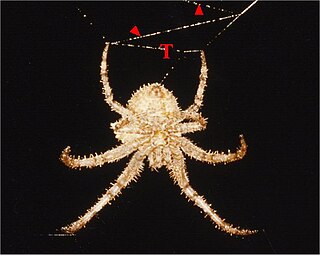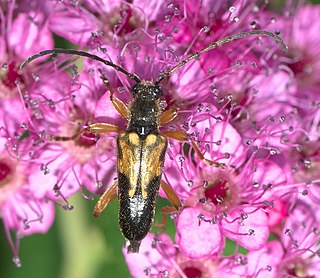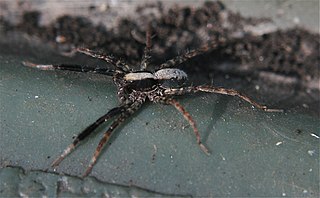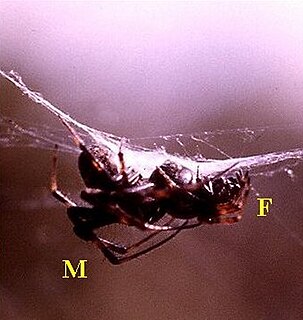
Selenocosmia crassipes, synonym Phlogius crassipes, also known as the "Queensland whistling tarantula" is a species of tarantula native to the east coast of Queensland, Australia. The name "whistling tarantula" comes from its ability to produce a hissing noise when provoked, a trait it shares with other Australian theraphosids. This hissing is produced by the spider stridulating a patch of setae associated with its chelicerae. It has also been called the "eastern tarantula". The species name crassipes is Latin for "fat leg" referring to the relatively fat front legs.

Kaira, sometimes called frilled orbweavers, is a mostly neotropical genus of orb-weaver spiders first described by O. Pickard-Cambridge in 1889. It includes sixteen described species that occur from South America up to the southern and eastern USA. It is presumably related to Aculepeira, Amazonepeira and Metepeira.

Metepeira labyrinthea, the labyrinth orbweaver, is an American dollar coin-sized spider, with thin legs and a round, bulbous abdomen It is a member of the genus Metepeira in the family Araneidae. The female’s length is 5.3 mm, its carapace 2.3 mm, abdomen 3.3 mm, and extended legs 18.4 mm. The carapace is brown or gray, and the abdomen is dark with a white pattern. The legs alternate pale brown and dark brown, and the sternum is dark brown with a longitudinal yellow mark. The male spider is three-quarters of the female’s length, or slightly larger, with a darker carapace and with greater contrast between dark and light areas of the legs. Metepeira are easily distinguished from other Araneidae by their light eye region, white median line on the sternum, relative length of the leg segments, small male palpus, weakly sclerotized epigyne and the special composite web.

Metepeira is a genus of orb-weaver spiders first described by F. O. Pickard-Cambridge in 1903. The name is derived from the Ancient Greek μετά and the obsolete genus name Epeira, denoting a genus similar to Epeira.
Metepeira ventura is a species of orb weaver in the spider family Araneidae. It is found in the United States and Mexico.
Metepeira spinipes is a species of orb weaver in the spider family Araneidae. It is found in the United States and Mexico.
Metepeira arizonica is a species of orb weaver in the spider family Araneidae. It is found in the United States and Mexico.
Metepeira foxi is a species of orb weaver in the spider family Araneidae. It is found in the United States and Canada.

Xestoleptura crassipes is a species of flower longhorn in the beetle family Cerambycidae. It is found in North America.
Metepeira gosoga is a species of orb weaver in the spider family Araneidae. It is found in the United States and Mexico.

Schizocosa crassipes is a species of wolf spider in the family Lycosidae. It is found in the United States.
Metepeira grandiosa is a species of orb weaver in the spider family Araneidae. It is found in North America.
Eisonyx crassipes is a species of flower weevil in the beetle family Curculionidae. It is found in North America.
Metepeira palustris is a species of orb weaver in the spider family Araneidae. It is found in the United States and Canada.
Pilophorus crassipes is a species of plant bug in the family Miridae. It is found in Central America and North America.
Metepeira pimungan is a species of orb weaver in the spider family Araneidae. It is found in the United States.
Metepeira comanche is a species of orb weaver in the spider family Araneidae. It is found in the United States and Mexico.
Metepeira minima is a species of orb weaver in the spider family Araneidae. It is found in a range from the United States to Honduras.
Metepeira datona is a species of orb weaver in the spider family Araneidae. It is found in the United States and Greater Antilles.

Metepeira incrassata, also known as the colonial orb-weaving spider, belongs to the spider family Araneidae and genus Metepeira. They are most famous for their social organization and group living behavior. They are generally found in tropical rainforest and agricultural sites in Mexico, and their habitats tend to be highly productive. Their group sizes are relatively larger than other colonial spiders, typically ranging from hundreds to thousands of individuals. 99% of the females are observed to participate in colonial living, generally with at least two other individuals. Because most M. incrassata females are communal, the colonies are often dominated by larger males. There is minimal sexual dimorphism observed in M. incrassata. Unlike other orb-weaver spiders, M. incrassata builds a colonial web by connecting each spider's individual webs together through semi-permanent framelines. These colonial webs of M. incrassata are prone to invasion by kleptoparasitic and araneophagic spiders such as the Theridiidae family. The reproductive cycle of M. incrassata occurs throughout the entire year, with multiple generations sharing the same time period. Within their colonies, M. incrassata is seen to change locations. Larger, fertile females with egg sacs prefer to reside in the central area of the group for increased protection from predators, while the younger spiders are mostly found in peripheral positions. Larger adult M. incrassata are also known to finish web-building earlier than smaller ones, gaining an advantage in strategically positioning themselves.






